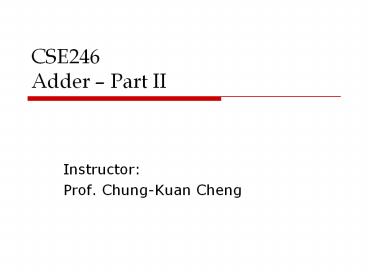CSE246 Adder - PowerPoint PPT Presentation
Title:
CSE246 Adder
Description:
Given depth constraint, generate a parallel prefix adder of minimum ... 7(GP[3,0]) Level 4. 8(GP[4,0]) Level 5. 8/30/09. 9. Dynamic Programming. Complexity ... – PowerPoint PPT presentation
Number of Views:88
Avg rating:3.0/5.0
Title: CSE246 Adder
1
CSE246Adder Part II
- Instructor
- Prof. Chung-Kuan Cheng
2
Zimmermans Heuristic Approach
- Problem formulation
- Given depth constraint, generate a parallel
prefix adder of minimum size - Two step Heuristic
- Start with a serial prefix adder
- Compress to a fastest prefix structure at the
cost of increasing size - LSB to MSB, low level to high level
- Expand to reduce size, subject to depth
constraint - MSB to LSB, high level to low level
3
Zimmermans Heuristic Approach
- Local compression/expansion operation
- Up/down shift
4
Zimmermans Heuristic Approach
- Advantages
- Simple and fast
- Product depth-size optimal result in many cases
- Handles non-uniform input arrival times
- Disadvantage
- No guarantee on optimality
5
Prefix Adder with arbitrary input arrival time
profile
- Non-uniform input arrival times represented in
real number - How to construct the fastest prefix adder under
arbitrary input arrival time profile?
6
Cont
- Timing model
- All (G,P) generators have the same delay C
- Denote the output timing of generator (G,P)ij
as tij - Suppose in the prefix graph, (G,P)ij is
generated from (G,P)jk and (G,P)k-1j, then
tij maxtik , tk-1j C
7
Dynamic Programming The idea
- Image a full array of partial prefix results
- All (G,P) signals of length i are on level i
- Rightmost signals are wanted prefix results
- Generate all the (G,P) signals row by row, from
lower level to higher level - For each (G,P) signal, find the scheme that leads
to best timing, i.e., find the partition point k
such that
tij minmaxtik , tk-1j C
tnn
tn-1n-1
t11
t22
k
tnn-1
t21
tnn-2
t31
tn2
tn-11
tn1
8
Dynamic Programming
- A 5-bit example
9
Dynamic Programming
- Complexity
- For (G,P)ij, search (i-j) combinations
- Overall O(n3)
- Hints for reducing complexity
- For (G,P)ij, there might more than one optimal
partition points, but we want just one - At least one optimal partition point of
(G,P)ij is bounded by the optimal partition
points of (G,P)i-1j and (G,P)ij1
10
Backward Reduction I
- Some of the partial prefix results are not used,
hence can be removed
Level 1
Level 2
Level 3
Level 4
Level 5
(a)
(b)
11
Backward Reduction II
- Some nodes may be over tightened, and can be
relaxed to reduce area
12
A missing detail
- (G,P) signals allows overlap ? search space
increases - However, allowing overlapping does not produce
better timing
(G,P)ij (G,P)ik (G,P)lj
l k
13
Function level optimization
- Carry Skip Adder
If p3,0p3p2p1p0 1, then x cin
14
False Path
- A1 lt- MUX lt- A0 lt- cin is a false path
- If carry is from cin, then block must have
p3p2p1p0 1 - Since p3,0 1, g3,0 must be 0
- The carry is not generated from A0
- The carry needs not to propagate via A0, it will
go from the MUX
15
False Path Cycles
- Cycles of False Paths Eg. 1s complement number
addition - Positive x
- Negative (2n-1)-x
- Addition
- (2n-1)-x (2n-1)-y 2n(2n-1)-(xy)-1
A3,0
B3,0
Cout
Cin
Adder
S3,0
16
Example
- 000
- 11111 0
- 11111 0
- 111110
- 111111 0
- -3-5 -8
- 11100 -3
- 11010 -5
- 110110
- 110111 -8
17
Multi-Operand Addition
- Carry save adder a (3,2) counter
18
Example
- A (3,2) counter compresses X rows to 2/3X rows
each time - Tree structure in implementation
19
Other Counters
- (7,3) counter
- (5,3) counter
S1
Ca
Cb
S0
S0
S2
- Design of (5,3) counter using full adders
Ca
Cb
S0































